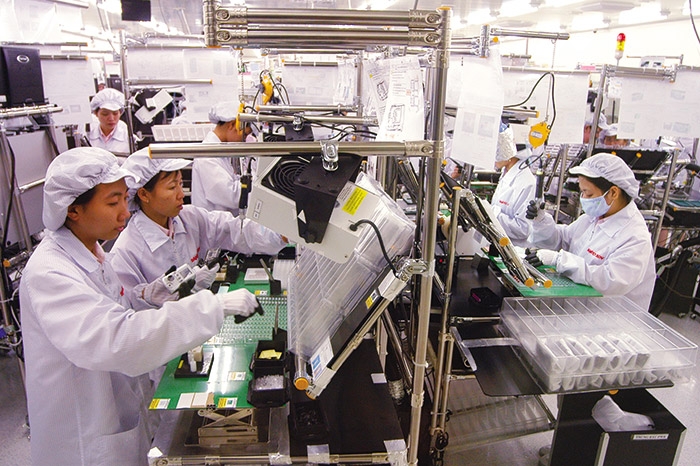Vietnam gets to grips with CPTPP
 |
| Through the ratification of the CPTPP, Vietnam will be able to attract even more foreign investment to key technology sectors, Photo: Le Toan |
Tran Hoang Ngan has spent days studying the Comprehensive and Progressive Agreement for Trans-Pacific Partnership (CPTPP). He is not a negotiator of the deal, but a National Assembly (NA) member from Ho Chi Minh City recently provided with documents related to the agreement, before it was officially discussed at the NA last week.
Initially, the deal was formed in 2005 as the Trans-Pacific Partnership (TPP) by Brunei, Chile, New Zealand and Singapore. The US joined the TPP in 2008, and Vietnam quickly followed suit. In January 2017 the US withdrew from the deal, which was then inked in March 2018 under the new name of the CPTPP.
“Why was Vietnam invited to join the TPP, though its per capita income is only $2,380, while the average of other member states is $30,000?” asked Ngan, who is also a senior economist.
“I think member states have foreseen the great potential Vietnam’s market and the vehement reform efforts being made. One of the most important reasons is that the states see a large market of 95 million, and big opportunities to invest in and export goods to the country,” he stressed.
Last week, NA members showed strong support to the CPTPP, stating that it should be adopted as soon as possible so that Vietnam can grasp many opportunities in luring investment, expanding trade, and boosting reforms.
The legislature is scheduled to pass the deal on November 12. So far six nations have adopted the deal – Australia, Canada, Mexico, Japan, New Zealand, and Singapore. Brunei, Chile, Malaysia, and Peru are expected to ratify it in the near future. This means the CPTPP will officially take effect on December 31, 2018 as at least 50 per cent of the original signatories will have ratified it.
Opportunities
“Vietnam’s partaking in and early adoption of the CPTPP demonstrates its strong commitments to broad-based, comprehensive international reform and integration, affirming the country’s important role and geopolitical status in Southeast Asia and the Asia-Pacific region,” stated Party General Secretary, State President Nguyen Phu Trong, in his proposal on the adoption of the CPTPP to the NA.
According to a government report delivered to the NA, the CPTPP will greatly benefit Vietnam as its GDP is about $11 trillion, or 13.5 per cent of the global GDP, including Japan as the world’s third-largest economy. Its total export-import turnover is over $10 trillion.
Under a study conducted recently by Vietnam’s Ministry of Planning and Investment (MPI), the agreement can expand Vietnam’s GDP and export turnover by 1.32 and 4.04 per cent, respectively, until 2035. Total import turnover will also likely rise by an additional 3.8 per cent until 2035.
“In terms of investment attraction, CPTPP commitments on services and investment will help Vietnam improve its investment climate and attract more foreign direct investment (FDI),” said the report. “In terms of institutional reforms, the CPTPP will help Vietnam further improve the local business and investment climate.”
Also according to the study, the deal will raise the number of jobs by 20,000-26,000 annually.
“Notably, the CPTPP will help Vietnam lure in more FDI, especially FDI from Canada, Australia, and New Zealand whose investments remain limited. We will have more choices in FDI as well,” Ngan said.
Under the MPI’s statistics, as of October 20, CPTPP nations registered over $120 billion of FDI in Vietnam, accounting for 35.7 per cent of the country’s total registered FDI, with Australia ($1.86 billion), Brunei ($1 billion), Canada ($5 billion), Chile ($15,000), Japan ($56.2 billion), Malaysia ($12.5 billion), Mexico ($58,000), New Zealand ($86.23 million), and Singapore ($46.22 billion).
According to the Ministry of Industry and Trade, the CPTPP will have a comprehensive and positive impact on Vietnam’s investment and trade as a whole, with garments, footwear, food and beverage sectors to be the biggest beneficiaries, as the majority of import tax rates for these sectors’ products will be reduced to 0 per cent when the CPTPP takes effect. Statistics show that Vietnam’s garment and textile export turnover from Australia, Canada, Mexico, New Zealand, Chile, and Peru, despite high import tax rates, sits at over $40 billion a year, which is 3.5 times higher than that from the US, and 11 times higher than from the EU.
Vietnam’s commitments to remove all tariff lines are slower than other nations. Upon entry into force, almost all nations have to reduce tariffs for Vietnamese goods, such as Canada (94 per cent of tariff lines), Chile (95 per cent), Japan (86 per cent), and Mexico (77 per cent). However, the rate for Vietnam is only 66 per cent, which will be increased to 86 per cent over the next three years.
According to the World Bank, the CPTPP is estimated to result in a cumulative increase of 1.1 per cent in Vietnam’s GDP by 2030. Assuming a modest boost to productivity, the estimated increase of the GDP would amount to 3.5 per cent from the CPTPP.
Meanwhile, the country’s exports are projected to grow by 4.2 per cent, and imports by 5.3 per cent, with larger increases of 6.9 and 7.6 per cent, assuming productivity gains.
In terms of sector impacts, the largest growth in output is estimated to be in food, beverages, and tobacco, clothing and leather, and textiles.
Also according to the World Bank, aside of the direct gains stemming from trade liberalisation and improved market access, the CPTPP is expected to stimulate and accelerate domestic reforms in many areas, such as competition, services (such as financial services, telecommunications, and temporary entry of service providers), customs, e-commerce, the environment, government procurement, intellectual property, investment, labour standards, legal issues, market access for goods, rules of origin, non-tariff measures, and trade remedies.
Concerns remain
However, according to the government, the CPTPP will also create many challenges for Vietnam.
“To implement CPTPP commitments, we will have to revise many regulations about trade, customs, intellectual property, and labour,” the government report reads. “We will also face a challenge in state budget revenue. The reduction and removal of import tariffs under the deal will lead to a decrease in the state revenue.”
To effectively implement CPTPP commitments, the government has asked the Ministry of Justice to combine with other ministries to review and amend the existing laws and regulations, and also enact new ones in a manner suitable to the commitments. Reviewing results showed that 265 legal documents must be reviewed, while seven laws will have to be amended in the time to come, including the Labour Code, the Criminal Code, the Criminal Procedure Code, and the laws on Anti-Corruption, Intellectual Property, Insurance Business, and Food Safety.
| CPTPP provides golden opportunity for Vietnam The historic trade deal, the Comprehensive and Progressive Agreement for Trans-Pacific Partnership is expected to soon be approved by the National Assembly. Warrick Cleine, chairman and CEO of KPMG Vietnam and Cambodia, shares his view with Dinh Thuy on how it could benefit Vietnamese companies amid the current US-China tensions and makes suggestions to mitigate adverse impacts and maximise gains from the deal.
In your opinion, what does the Comprehensive and Progressive Agreement for Trans-Pacific Partnership (CPTPP) mean for its members, particularly Vietnam, amid the current US-China trade war? How could it and other new-generation free trade agreements (FTA) benefit Vietnamese companies? The Trump administration is challenging multi-lateral rules-based trade policy, questioning the effectiveness of the World Trade Organization and imposing actual or threatened tariffs on certain trading partners, especially China. The US-China trade war creates significant long-term risks for Vietnam as the “America First” premise is based on a desire to move manufacturing jobs to the US, not to other countries, and because it undercuts the basis and importance of multilateral trading agreements, which have been very beneficial to Vietnam. In the short term, though, manufacturers are seeking to move capacity out of China, avoiding punitive US tariffs that will attach to a “Made in China” label, and Vietnam is a significant beneficiary of this trend. But this ought to be viewed in the context of a larger trend, now relevant for 25 years, of export manufacturers investing in Vietnam to utilise its famously productive labour, increasingly suitable physical infrastructure, and quality trade agreements. KPMG has launched a “Make in Vietnam” initiative to assist our clients to locate and expand manufacturing capacity in Vietnam. Vietnam is now one of the world’s most important exporting nations, both in relation to commodities such as rice, coffee, pepper, and seafood, and more recently manufactured goods such as footwear, garments, and electronics. The country has been very active in international trade for the past 25 years or more, negotiating trade agreements with its important trading partners, entering into multilateral arrangements such as the WTO and the ASEAN Economic Community (AEC), and more recently entering into the Vietnam-EU FTA and the CPTPP. These agreements bind Vietnam to a multilateral rules-based trading system, and have been incredibly successful at powering Vietnam’s export story, creating career opportunities and prosperity for Vietnamese people, and contributing to macroeconomic stability. Under the CPTPP, what tax matters should Vietnamese businesses be concerned with? What are your suggestions for Vietnam to maximise benefits from the CPTPP? The CPTPP concerns trade and investment, and does not address corporate or indirect tax concerns. Customs duties are a principal focus of trade agreements, and particularly the reduction or elimination of duties, provided conditions are met. The CPTPP is incredibly important for Vietnamese exporters, as it will enable them to sell Vietnamese commodities and manufactured goods to other member firms, often free of duty. This should give Vietnamese exports an advantage when selling into markets such as Canada, Australia or Japan over exports from non-CPTPP countries, such as China or the US, or even other ASEAN members, such as Thailand or Indonesia. The important thing for Vietnamese exporters to understand is that the CPTPP is a new-generation FTA, which imposes greater requirements on exporting countries to qualify for concessional treatment. This can extend to environmental, labour, and intellectual property issues. It is not simply good enough to obtain a Vietnamese Certificate of Origin. Not enough Vietnamese exporters, especially small- and- medium sized enterprises (SMEs), are aware of the requirements. The Vietnamese government has done a remarkable job of negotiating Vietnam’s entry into the CPTPP. Now businesses need to understand and seize the opportunities. How will Vietnam’s economy change with the CPTPP and what should Vietnamese companies do to outshine foreign competition? The CPTPP requires Vietnam to provide easier market access for companies from other CPTPP countries, and we should expect more imports and investment from countries such as Japan, Canada, Australia, and New Zealand. This will be great for Vietnamese consumers, and will provide more competition for Vietnamese domestic producers. This is not likely to create significant risks for Vietnamese companies, who have proven overall to be adaptable and competitive against foreign producers since the trading sector was opened up over 25 years ago. While foreign companies flooded into the market with new products that gained significant market share in the mid-1990s, Vietnamese entrepreneurs responded with their own products and brands, creating “national champions” such as Vinamilk, Masan Consumer, Vietjet, Vinfast, and others along the way. Vietnam’s experience with foreign competition is that it encourages local companies to improve themselves in order to both thrive and survive. KPMG’s Strategy Consulting and Digital Consulting teams in Vietnam, for example, work with many leading companies in Vietnam to help them understand and respond to foreign competition. The CPTPP will further encourage this trend. |
Wendy Matthews, New Zealand Ambassador to Vietnam
 |
One thing I think New Zealand and Vietnam have in common is that both of us are open traders. We know that in order to survive and thrive in the modern world we need to export. So what I’ve really appreciated about Vietnam is even though global protectionism has grown throughout the world, New Zealand and Vietnam have both been very similar in terms of still wanting to strive for regional economic integration. The CPTPP is a great example in which we have both committed to. With this, both New Zealand and Vietnam know that a connection with the surrounding Asia Pacific countries needs to be even stronger for us to prosper.
Although tariffs are a key part of the CPTPP, it’s much more than. It’s making sure that our service suppliers and investors can better move between countries, allowing some of the red tape to be cut, and how to make it easier for them to really build sustainable value chains in the Asia-Pacific region. I think there are a lot of opportunities for both countries with the CPTPP, what we now need is businesspeople to step through the door.
New Zealand is one of the first six countries to ratify the CPTPP, so we’re very pleased that it will come into force this year. I believe Vietnam is very close, it’s been considered by the National Assembly now, so I’m expecting by the end of the year Vietnam will also join the group.
Kevin Hawkins, Co-executive partner, ZICO Law Vietnam
 |
We understand Vietnam’s National Assembly will ratify the CPTPP on November 12. The treaty should come into full effect on December 31. Although the withdrawal of the US from the predecessor TPP treaty caused much concern, and significantly reduced the scale of benefits to be achieved, the current 11 member countries still represent about 13.4 per cent of the world’s GDP.
With ZICO Law being a regional law firm, this represents a significant opportunity for our ability to deliver seamless legal advice to CPTPP member countries, especially when Thailand, the Philippines, and Indonesia later join the CPTPP as they have indicated.
For our work in Vietnam, we expect to see an increase in investment activity because, not only were 90 per cent of the trade barriers removed, but also because provisions on intellectual property protection, e-commerce regulation, investment protection and investor-state dispute settlements were agreed by member countries.
With clearer rules and guidelines between the CPTPP members in place, we can expect foreign investors to have more confidence when deciding to invest in member countries, including Vietnam.
Kenneth Atkinson, Executive chairman, Grant Thornton
 |
The markets covered by 11 countries, who are currently signed up to the CPTPP, cover over 13 per cent of global GDP and a market of over 500 million. As such, the CPTPP will offer great opportunities to both foreign and domestic firms in Vietnam. Due to tariff cuts, many opportunities will accrue to export orientated companies. In those markets however, other benefits are expected such as market access for foreign companies wishing to enter Vietnam. The CPTPP is also expected to stimulate domestic reforms in several areas such as financial services, telecommunications, customs, and intellectual property to name a few. Therefore in Vietnam we see little direct impact on our own business as a result of the CPTPP, but the indirect impact could be quite significant.
The CPTPP will surely enhance export opportunities to markets such as Japan, Australia and Canada, particularly in the textile, footwear and electronic goods industries through the tariff cut commitments under the deal. These enhanced opportunities should also help lure more foreign direct investment into these sectors, as well as accelerating the shift of manufacturing investments from China to Vietnam.
One of the challenges to Vietnam is that CPTPP also imposes high standards of governance and transparency.
Karen Cvornyek, President and managing Principal in Asia, B+H Architects
 |
Since B+H first established its Vietnam studio in 2010, we have witnessed firsthand how rapidly the country has transformed through a strong focus on modernisation and an innovative spirit.
As we look towards the future, the roadmap for Vietnam to play a role on the world stage in shaping the future of sustainable urban development is clear.
The CPTPP will bolster this by supercharging the growth of Vietnam’s economy, creating unprecedented opportunities for its people along with the need for a more healthy and dynamic infrastructure to support its ever growing population.
Successful urban development in Vietnam will require a holistic, culturally sensitive approach that considers social and environmental factors to be of equal importance to economic conditions.
Larry Madge, General director, Sun Life Vietnam
 |
As a subsidiary of a Canadian company, Sun Life Vietnam was pleased to see the ratification of the CPTPP by Canada last month and the anticipated ratification by Vietnam this week. The agreement is expected to boost GDP growth in Vietnam which will enable more of the population to be able to afford financial products and services which means we can better achieve our purpose of helping our clients achieve lifetime financial security and live healthier lives.
We have a number of things that emanate from our Canadian heritage which we are proud of, and that we bring to Vietnam. Two examples would be the culture we are trying to create for our employees. We focus on enabling employees to develop to their full potential and to contribute fully through programmes. We’re also proud of our company purpose to help our clients achieve lifetime financial security and live healthier lives.
What the stars mean:
★ Poor ★ ★ Promising ★★★ Good ★★★★ Very good ★★★★★ Exceptional
 Tag:
Tag:
Themes: CPTPP
Related Contents
Latest News
More News
- PM orders investment model for North–South high-speed rail (December 22, 2025 | 17:43)
- First members of Danang International Finance Centre revealed (December 22, 2025 | 17:39)
- Securing capital and efficiency for Vietnam’s 2026-2030 growth ambitions (December 17, 2025 | 10:00)
- Driving double-digit growth through green and circular transformation in Vietnam (December 17, 2025 | 09:00)
- Vietnam bucking trend in the global M&A landscape (December 16, 2025 | 14:20)
- Vietnam’s green transition demands collective financial action (December 15, 2025 | 12:00)
- VIR workshop highlights capital and policy for sustainable development (December 15, 2025 | 11:00)
- National Assembly approves pilot mechanisms to accelerate major projects in Hanoi (December 12, 2025 | 11:29)
- Vietnam eases policy approval requirements, simplifies foreign and outbound investments (December 11, 2025 | 17:53)
- Unpacking new momentum in Vietnam’s M&A market (December 10, 2025 | 09:59)
























 Mobile Version
Mobile Version